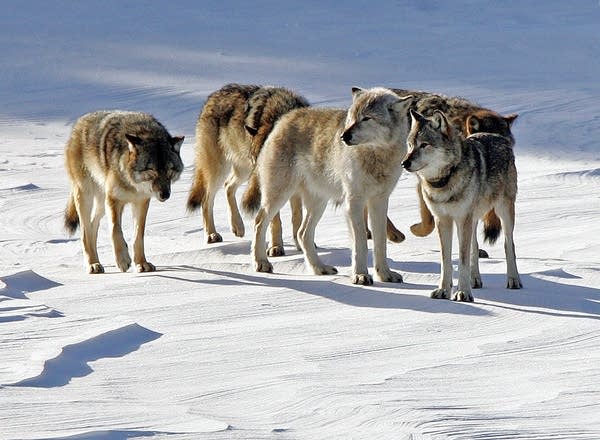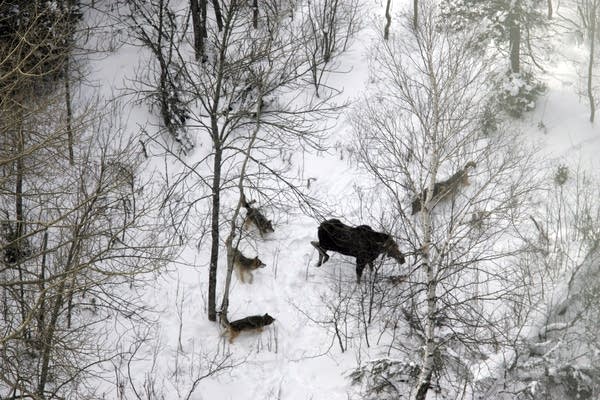Isle Royale researchers debate intervention to help wolf population
Go Deeper.
Create an account or log in to save stories.
Like this?
Thanks for liking this story! We have added it to a list of your favorite stories.

The wolf population on Isle Royale is down to eight individuals and for the first time in 50 years of intense study there is no evidence of reproduction over the winter.
The National Park Service faces a thorny set of choices to either intervene or let nature take its course. A panel of experts Thursday evening will debate the options and explore possible consequences.
• Today's Question: Should humans intervene?
Isle Royale is a unique place -- 200 square miles of rugged woods and swamps, rocks and waves. Perched 15 miles from the Minnesota shore in Lake Superior it is effectively isolated from the mainland. For more than 50 years scientists have trekked to this self-contained ecosystem to study the relationship between wolves and moose.
Turn Up Your Support
MPR News helps you turn down the noise and build shared understanding. Turn up your support for this public resource and keep trusted journalism accessible to all.
Last year, researchers found only eight wolves -- the fewest wolves ever recorded on the island. There are plenty of moose for the wolves to eat. But with all eight wolves being descended from a single female, scientists think the population may be too inbred to reproduce anymore.

In considering what to do next, the National Park Service is investigating three options: the first is to do nothing, let nature take its course. The wolves may or may not die out. The second option is to introduce one or more new wolves to provide fresh genetic material. The third option is to wait until the current population dies out and then introduce a new group of wolves.
The lead researchers in the 55-year-long study, Rolf Peterson and John Vucetich, have published an article in the op-ed page of The New York Times arguing for a swift genetic rescue. They say it is true the island is designated a wilderness, but the human footprint is now evident on Isle Royale and practically everywhere else. They say it is time to place the highest value on ecosystem's health, even if humans need to intervene to maintain it. And they say a healthy ecosystem depends on having a top predator, such as wolves, to keep everything else in balance.
"If we don't do anything now, we can do something later if it's necessary. But if we do something now, we can never undo that,"
But other researchers disagree. Dave Mech, a wolf expert with the U.S. Geological Survey, said science will gain the most if we wait and see.
"If we don't do anything now, we can do something later if it's necessary. But if we do something now, we can never undo that," Mech said. "We have a pure population just doing its thing. And we have 55 years of data on it; why not see what else can happen here?"
A hundred years ago, Isle Royale had a different wildlife population. It had no moose and no wolves. It was home to caribou, coyotes and lynx.
Nancy Gibson, co-founder of the International Wolf Center in Ely, said if interfering with the current wildlife population is up for discussion, broader options should be considered.
"Maybe should we reintroduce caribou? It's also an ecosystem that doesn't have bears," Gibson said. "I also think it's a little bit interesting that we're not talking about introducing lynx back to Isle Royale. It's a very interesting dilemma, and I think we really need to have a vigorous debate on it."
Tonight's forum in Minneapolis is the public beginning of that debate. The National Park Service will hear input from scientists and the general public in a decision-making process that will span several months.

Sponsors of the forum are the Sigurd Olson Environmental Institute at Northland College and the National Parks Conservation Association.
Christine Goepfert, the association's upper Midwest program manager, is concerned whether any human intervention is sustainable. She points out the ice bridges that allowed wolves to travel from the mainland to the island are less likely to form as the climate warms.
"We know it's unlikely ever again to have a moose and/or wolf make its own way there. Are we always going to have to continuously intervene, and how often," Goepfert said. "I also wonder how that affects the research, if we're having to do that. So there's a lot of unanswered questions in my mind."
The forum is 7 to 9 p.m. Thursday in the Cowles Auditorium at the University of Minnesota's Humphrey Institute.




